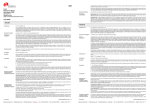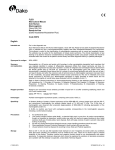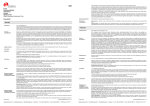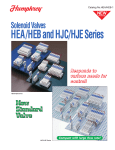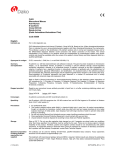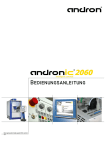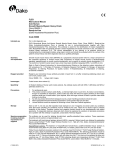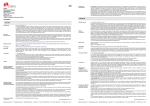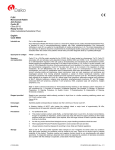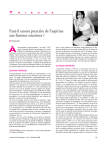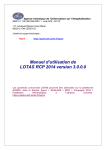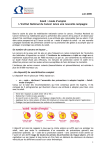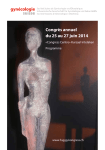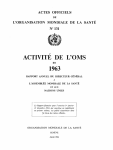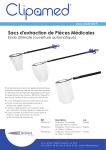Download FLEX Monoclonal Mouse Anti-Human Epithelial Antigen
Transcript
The recommended negative control reagent is FLEX Negative Control, Mouse, (Dako Autostainer/Autostainer Plus) (Code IS750). FLEX Monoclonal Mouse Anti-Human Epithelial Antigen Clone Ber-EP4 Ready-to-Use (Dako Autostainer/Autostainer Plus) Staining interpretation Cells labeled by the antibody display cytoplasmic and membrane staining. The membrane staining is preferentially basolateral (4). Performance characteristics Normal tissues: All normal epithelial tissues are labeled by the antibody. Epithelial cells of different origin display varying levels of staining, but most epithelia are strongly positive. Only parietal cells in gastric glands, apical cell layers in squamous epithelia, and adult hepatocytes are negative (4). The antibody does not label non-epithelial tissues, including spleen, peripheral blood, bone marrow, brain, connective tissue, smooth and striated muscle, heart, endothelia, and myoepithelia. Additionally pleura and peritoneum-lining cells are negative, but cells covering the ovary display a slight staining (4). In colon, the column epithelial cells show a moderate to strong staining reaction. In kidney, the epithelial cells lining the bowman capsule show a weak to moderate staining reaction. Abnormal tissues: The antibody labeled 142 of 144 epithelial tumor specimens, irrespective of their differentiation, derived from breast, esophagus, stomach, colon, rectum, pancreas, kidney, liver, lung, thyroid and salivary glands, vagina, ovary, cervix uteri and nasopharynx, reflecting the staining pattern in their non-malignant counterparts. Hepatocellular carcinomas displayed heterogeneous staining and included the two negative cases. In this study (4), 2 of 2 squamous cell carcinomas of the lung and cervix uteri, respectively, were positive in formalin-fixed, paraffin-embedded specimens, even though only the basal cell layers were labeled in normal tissues. In some carcinomas, such as gastric carcinomas, the antibody demonstrated a stronger labeling than in normal tissues, especially on the membrane. None of 88 non-epithelial tumors and 20 cases of leukemia were labeled by the antibody (4). In a study of 83 adenocarcinomas and 115 malignant mesotheliomas, 72/83 adenocarcinomas were labeled by the antibody whereas only 1/115 malignant mesotheliomas was labeled (1). In another study, 20/20 lung adenocarcinomas and 4/46 mesotheliomas were labeled. Of the 4 positive mesotheliomas, the 2 showed a strictly focal labeling (6). In lymph nodes classified as tumor free by conventional histopathological staging, the antibody labeled micrometastatic tumor cells in 89 of 126 patients with completely resected esophageal carcinomas (2). In a study of 75 skin tumors, the antibody labeled 39/39 basal cell carcinomas, 0/23 squamous cell carcinomas, and showed some areas of staining in 13/13 basosquamous carcinomas (3). Code IS637 ENGLISH FRANÇAIS For in vitro diagnostic use. Intended use FLEX Monoclonal Mouse Anti-Human Epithelial Antigen, Clone Ber-EP4, Ready-to-Use, (Dako Autostainer/Autostainer Plus), is intended for use in immunohistochemistry together with Dako Autostainer/Autostainer Plus instruments. This antibody labels most epithelial cells and is useful in the differential diagnosis of adenocarcinoma versus malignant mesothelioma (1). The antibody may also aid in the detection of micrometastases in lymph nodes of patients with esophageal carcinoma (2) and in differentiating between basal and squamous cell carcinomas of the skin (3). The clinical interpretation of any staining or its absence should be complemented by morphological studies using proper controls and should be evaluated within the context of the patient's clinical history and other diagnostic tests by a qualified pathologist. Synonym for antigen Ep-CAM Summary and explanation Epithelial antigen is a transmembrane glycoprotein functioning as a cellular adhesion molecule. This epithelium-specific antigen is broadly distributed in epithelial cells, and displays a highly conserved expression in carcinomas (4, 5). As exceptions to the general expression in normal epithelia, adult hepatocytes, in contrast to fetal hepatocytes, parietal cells in gastric glands, and apical cells in squamous epithelia are negative. Epithelial antigen is rarely present in mesotheliomas (1, 4). It has been reported that epithelial antigen plays an important role as tumor-cell marker in lymph nodes from patients with esophageal carcinoma otherwise classified as node-negative (2). Epithelial antigen has also been suggested as a discriminator between basal cell and basosquamous carcinomas, and squamous cell carcinoma of the skin (3). Pour utilisation lors d’un diagnostic in vitro. Utilisation prévue FLEX Monoclonal Mouse Anti-Human Epithelial Antigen, Clone Ber-EP4, Ready-to-Use, (Dako Autostainer/Autostainer Plus), est destiné à une utilisation en immunohistochimie avec les instruments Dako Autostainer/Autostainer Plus. Cet anticorps marque la plupart des cellules épithéliales et est très utile pour le diagnostic différentiel entre un adénocarcinome et un mésothéliome malin (1). L’anticorps peut également aider à la détection de micro-métastases dans les ganglions lymphatiques de patients atteints d’un carcinome de l’œsophage (2) et pour la différenciation entre les carcinomes spinocellulaires et basocellulaires de la peau (3). L’interprétation clinique de toute coloration ou son absence doit être complétée par des études morphologiques en utilisant des contrôles appropriés et doit être évaluée en fonction des antécédents cliniques du patient et d’autres tests diagnostiques par un pathologiste qualifié. Synonyme de l’antigène Ep-CAM. Résumé et explication L’antigène épithélial est une glycoprotéine transmembranaire fonctionnant comme une molécule d’adhésion cellulaire. Cet antigène spécifique de l’épithélium est largement réparti dans les cellules épithéliales et présente une expression hautement conservée dans les carcinomes (4,5). Faisant exception à l’expression générale dans les épithéliums normaux, les hépatocytes adultes, contrairement aux hépatocytes fœtaux, les cellules pariétales des glandes gastriques et les cellules apicales dans les épithéliums simples pavimenteux sont négatifs. L’antigène épithélial est rarement présent dans les mésothéliomes (1,4). On a rapporté que l’antigène épithélial joue un rôle important comme marqueur de cellule cancéreuse dans les ganglions lymphatiques de patients atteints de carcinome de l’œsophage classés autrement comme ganglion-négatifs (2). Il a également été suggéré que l’antigène épithélial pouvait être un discriminant entre les carcinomes basocellulaires basospinocellulaires et spinocellulaires de la peau (3). Refer to Dako’s General Instructions for Immunohistochemical Staining or the detection system instructions of IHC procedures for: 1) Principle of Procedure, 2) Materials Required, Not Supplied, 3) Storage, 4) Specimen Preparation, 5) Staining Procedure, 6) Quality Control, 7) Troubleshooting, 8) Interpretation of Staining, 9) General Limitations. Ready-to-use monoclonal mouse antibody provided in liquid form in a buffer containing stabilizing protein and 0.015 mol/L sodium azide. Reagent provided Se référer aux Instructions générales de coloration immunohistochimique de Dako ou aux instructions du système de détection relatives aux procédures IHC pour plus d’informations concernant les points suivants : 1) Principe de procédure, 2) Matériels requis mais non fournis, 3) Conservation, 4) Préparation des échantillons, 5) Procédure de coloration, 6) Contrôle qualité, 7) Dépannage, 8) Interprétation de la coloration, 9) Limites générales. Clone: Ber-EP4 (4). Isotype: IgG1, kappa. Immunogen MCF-7 cells (human breast carcinoma cell line) (4). Specificity Analysis of immunocomplexes between the antibody and lysate of 125I surface-labeled MCF-7 cells in SDS-PAGE under reducing conditions shows that the antibody labels two polypeptides of 34 kDa and 39 kDa, respectively, corresponding to epithelial antigen. Under non-reducing conditions, the polypeptides appear as 39 kDa and 41 kDa, while deglycosylation reduces the size to 31 kDa, and 36 kDa. In immunoprecipitation experiments, the Ber-EP4 antibody blocks the reaction of the HEA125 antibody with MCF-7 cell lysate and vice versa, showing that the two antibodies react with the same antigen. The two antibodies also produce identical staining results in cells and tissues (4). Anticorps monoclonal de souris prêt à l’emploi fourni sous forme liquide dans un tampon contenant une protéine stabilisante et 0,015 mol/L d’azide de sodium. Réactifs fournis Clone : Ber-EP4 (4). Isotype : IgG1, kappa. Immunogène Cellules MCF -7 (lignée cellulaire de carcinome mammaire humain) (4). Spécificité L’analyse des immunocomplexes entre l’anticorps et le lysat de 125I cellules MCF-7 marquées en surface, en analyse PAGE-SDS dans des conditions réductrices, montre que l’anticorps marque deux polypeptides de 34 kDa et 39 kDa, respectivement, correspondant à l’antigène épithélial. Dans des conditions non réductrices, les polypeptides apparaissent comme faisant 39 kDa et 41 kDa, tandis que la déglycosilation réduit la taille à 31 kDa et 36 kDa. Of 37 cell lines tested, the antibody homogeneously labels all (10/10) carcinoma cell lines, whereas all non-epithelial cell lines (26/27) are negative except for the erythromyeloid cell line K562 (4). Precautions 1. For professional users. Dans les expérimentations d’immunoprécipitation, l’anticorps Ber-EP4 bloque la réaction de l’anticorps HEA125 avec le lysat de cellules MCF-7 et vice-versa, montrant que les deux anticorps réagissent avec le même antigène. Les deux anticorps présentent aussi une coloration identique dans les cellules et les tissus (4). 2. This product contains sodium azide (NaN3), a chemical highly toxic in pure form. At product concentrations, though not classified as hazardous, sodium azide may react with lead and copper plumbing to form highly explosive build-ups of metal azides. Upon disposal, flush with large volumes of water to prevent metal azide build-up in plumbing. Sur 37 lignées cellulaires testées, l’anticorps a marqué de manière homogène toutes (10/10) les lignées cellulaires des carcinomes, alors que toutes les lignées cellulaires non-épithéliales (26/27) sont négatives à l’exception de la lignée cellulaire érythromyéloïde K562 (4). 3. As with any product derived from biological sources, proper handling procedures should be used. 1. Pour utilisateurs professionnels. Précautions 4. Wear appropriate Personal Protective Equipment to avoid contact with eyes and skin. Storage Specimen preparation including materials required but not supplied 5. Unused solution should be disposed of according to local, State and Federal regulations. 2. Ce produit contient de l’azide de sodium (NaN3), produit chimique hautement toxique dans sa forme pure. Aux concentrations du produit, bien que non classé comme dangereux, l’azide de sodium peut réagir avec le cuivre et le plomb des canalisations et former des accumulations d’azides métalliques hautement explosifs. Lors de l’élimination, rincer abondamment à l’eau pour éviter toute accumulation d’azide métallique dans les canalisations. Store at 2-8 °C. Do not use after expiration date sta mped on vial. If reagents are stored under any conditions other than those specified, the conditions must be verified by the user. There are no obvious signs to indicate instability of this product. Therefore, positive and negative controls should be run simultaneously with patient specimens. If unexpected staining is observed which cannot be explained by variations in laboratory procedures and a problem with the antibody is suspected, contact Dako Technical Support. 4. Porter un vêtement de protection approprié pour éviter le contact avec les yeux et la peau. The antibody can be used for labeling formalin-fixed, paraffin-embedded tissue sections. Tissue specimens should be cut into sections of approximately 4 µm. 3. Comme avec tout produit d’origine biologique, des procédures de manipulation appropriées doivent être respectées. 5. Les solutions non utilisées doivent être éliminées conformément aux réglementations locales et nationales. Conservation Conserver entre 2 et 8 °C. Ne pas utiliser après la date de péremption indiquée sur le flacon. Si les réactifs sont conservés dans des conditions autres que celles indiquées, celles-ci doivent être validées par l’utilisateur. Il n’y a aucun signe évident indiquant l’instabilité de ce produit. Par conséquent, des contrôles positifs et négatifs doivent être testés en même temps que les échantillons de patient. Si une coloration inattendue est observée, qui ne peut être expliquée par un changement des procédures du laboratoire, et en cas de suspicion d’un problème lié à l’anticorps, contacter l’assistance technique de Dako. Préparation des échantillons y compris le matériel requis mais non fourni L’anticorps peut être utilisé pour le marquage des coupes de tissus inclus en paraffine et fixés au formol. L’épaisseur des coupes d’échantillons de tissu doit être d’environ 4 µm. Pre-treatment with heat-induced epitope retrieval (HIER) is required using Dako PT Link (Code PT100/PT101). For details, please refer to the PT Link User Guide. Optimal results are obtained by pretreating tissues using EnVision FLEX, Target Retrieval Solution, Low pH (50x) (Code K8005). Paraffin-embedded sections: Pre-treatment of formalin-fixed, paraffin-embedded tissue sections is recommended using the 3-in-1 specimen preparation procedure for Dako PT Link. Follow the pre-treatment procedure outlined in the package insert for EnVision FLEX, Target Retrieval Solution, Low pH (50x) (Code K8005). Note: After staining the sections must be dehydrated, cleared and mounted using permanent mounting medium. Deparaffinized sections: Pre-treatment of deparaffinized formalin-fixed, paraffin-embedded tissue sections is recommended using Dako PT Link and following the same procedure as described for paraffin-embedded sections. After staining the slides should be mounted using aqueous or permanent mounting medium. The tissue sections should not dry out during the treatment or during the following immunohistochemical staining procedure. For greater adherence of tissue sections to glass slides, the use of FLEX IHC Microscope Slides (Code K8020) is recommended. Staining procedure including materials required but not supplied Coupes incluses en paraffine : le prétraitement des coupes tissulaires fixées au formol et incluses en paraffine est recommandé à l'aide de la procédure de préparation d'échantillon 3-en-un pour le Dako PT Link. Suivre la procédure de prétraitement indiquée dans la notice de la EnVision FLEX, Target Retrieval Solution, Low pH (50x) (Réf. K8005). Remarque : après coloration, les coupes doivent être déshydratées, lavées et montées à l’aide d’un milieu de montage permanent. The recommended visualization system is EnVision FLEX, High pH, (Dako Autostainer/Autostainer Plus) (Code K8010), replacing the High pH Target Retrieval Solution from this kit with EnVision FLEX Target Retrieval Solution, Low pH (50x) (Code K8005). The staining steps and incubation times are pre-programmed into the software of Dako Autostainer/Autostainer Plus instruments, using the following protocols: Coupes déparaffinées : le prétraitement des coupes tissulaires déparaffinées, fixées au formol et incluses en paraffine, est recommandé à l’aide du Dako PT Link, en suivant la même procédure que pour les coupes incluses en paraffine. Après coloration, un montage aqueux ou permanent des lames est recommandé. Template protocol: FLEXRTU2 (200 µL dispense volume) or FLEXRTU3 (300 µL dispense volume) Autoprogram: BerEP4 (without counterstaining) or BerEP4H (with counterstaining) The Auxiliary step should be set to “rinse buffer” in staining runs with ≤10 slides. For staining runs with >10 slides the Auxiliary step should be set to “none”. This ascertains comparable wash times. All incubation steps should be performed at room temperature. For details, please refer to the Operator’s Manual for the dedicated instrument. If the protocols are not available on the used Dako Autostainer instrument, please contact Dako Technical Services. Les coupes de tissus ne doivent pas sécher lors du traitement ni lors de la procédure de coloration immunohistochimique suivante. Pour une meilleure adhérence des coupes de tissus sur les lames de verre, il est recommandé d’utiliser des lames FLEX IHC Microscope Slides (réf. K8020). Procédure de coloration y compris le matériel requis mais non fourni Optimal conditions may vary depending on specimen and preparation methods, and should be determined by each individual laboratory. If the evaluating pathologist should desire a different staining intensity, a Dako Application Specialist/Technical Service Specialist can be contacted for information on reprogramming of the protocol. Verify that the performance of the adjusted protocol is still valid by evaluating that the staining pattern is identical to the staining pattern described in “Performance characteristics”. L’étape Auxiliary doit être réglée sur « rinse buffer » lors des cycles de coloration avec ≤ 10 lames. For staining runs with >10 slides the Auxiliary step should be set to “none”.Pour les cycles de coloration de >10 lames, l’étape Auxiliary doit être réglée sur « none ». Cela confirme des temps de lavage comparables. Toutes les étapes d’incubation doivent être effectuées à température ambiante. Pour plus de détails, se référer au Manuel de l’opérateur spécifique à l'instrument. Si les protocoles ne sont pas disponibles sur l’instrument Dako Autostainer utilisé, contacter le service technique de Dako Positive and negative controls should be run simultaneously using the same protocol as the patient specimens. The positive control tissue should include colon and kidney and the cells/structures should display reaction patterns as described for this tissue in “Performance characteristics” in all positive specimens. Dako Denmark A/S IS637/EFG/MNI/2009.12.04 p. 1/4 | Produktionsvej 42 | DK-2600 Glostrup | Denmark | Tel. +45 44 85 95 00 | Fax +45 44 85 95 95 | CVR No. 33 21 13 17 Le système de visualisation recommandé est EnVision FLEX, High pH, (Dako Autostainer/Autostainer Plus) (Code K8010), remplaçant la High pH Target Retrieval Solution de ce kit avec la EnVision FLEX Target Retrieval Solution, Low pH (50x) (Code K8005). Les étapes de coloration et les temps d’incubation sont préprogrammés dans le logiciel des instruments Dako Autostainer/Autostainer Plus, à l’aide des protocoles suivants : Protocole modèle : FLEXRTU2 (volume d’application de 200 µL) ou FLEXRTU3 (volume d’application de 300 µL) Programme automatique : BerEP4 (sans contrecoloration) ou BerEP4H (avec contre-coloration). Counterstaining in hematoxylin is recommended using EnVision FLEX Hematoxylin, (Dako Autostainer/Autostainer Plus) (Code K8018). Non-aqueous, permanent mounting medium is recommended. (117048-003) Un prétraitement avec démasquage d’épitope induit par la chaleur (HIER) est nécessaire avec le Dako PT Link (Réf. PT100/PT101). Pour plus de détails, se référer au Guide d’utilisation du PT Link. Des résultats optimaux sont obtenus en prétraitant les tissus à l’aide de la EnVision FLEX, Target Retrieval Solution, Low pH (50x) (Réf. K8005). Les conditions optimales peuvent varier en fonction du prélèvement et des méthodes de préparation, et doivent être déterminées par chaque laboratoire (117048-003) Dako Denmark A/S IS637/EFG/MNI/2009.12.04 p. 2/4 | Produktionsvej 42 | DK-2600 Glostrup | Denmark | Tel. +45 44 85 95 00 | Fax +45 44 85 95 95 | CVR No. 33 21 13 17 individuellement. Si le pathologiste qui réalise l’évaluation désire une intensité de coloration différente, un spécialiste d’application/spécialiste du service technique de Dako peut être contacté pour obtenir des informations sur la re-programmation du protocole. Vérifier que l’exécution du protocole modifié est toujours valide en vérifiant que le schéma de coloration est identique au schéma de coloration décrit dans les « Caractéristiques de performance ». Färbeverfahren und erforderliche, aber nicht mitgelieferte Materialien Il est recommandé d’effectuer une contre-coloration à l’aide d’hématoxyline EnVision FLEX Hematoxylin, (Dako Autostainer/Autostainer Plus) (Code K8018). L’utilisation d’un milieu de montage permanent non aqueux est recommandée. Matrix-Protokoll: FLEXRTU2 (200 µl Anwendungsvolumen) oder FLEXRTU3 (300 µl Anwendungsvolumen) Autoprogramm: BerEP4 (ohne Gegenfärbung) oder BerEP4H (mit Gegenfärbung) Des contrôles positifs et négatifs doivent être réalisés en même temps et avec le même protocole que les échantillons du patient. Le contrôle de tissu positif doit comprendre le rein et le côlon et les cellules/structures doivent présenter les schémas de réaction décrits pour ces tissus dans les « Caractéristiques de performance » pour tous les échantillons positifs. Le contrôle négatif recommandé est le FLEX Negative Control, Mouse, (Dako Autostainer/Autostainer Plus) (Code IS750). Interprétation de la coloration Les cellules marquées par l’anticorps présentent une coloration cytoplasmique et membranaire. La coloration membranaire est plutôt basolatérale (4). Caractéristiques de performance Tissus sains : tous les tissus épithéliaux normaux sont marqués par l’anticorps. Les cellules épithéliales d’origines différentes affichent des niveaux de coloration variés, mais la plupart des épithéliums sont fortement positifs. Seuls les cellules pariétales des glandes gastriques, les cellules apicales des épithéliums simples pavimenteux et les hépatocytes adultes sont négatifs (4). L’anticorps ne marque pas les tissus non épithéliaux, notamment la rate, le sang périphérique, la moelle osseuse, le cerveau, le tissu conjonctif, les muscles lisses et striés, le cœur, les endothéliums et les myoépithéliums. En outre, les cellules tapissant la plèvre et le péritoine sont négatives mais les cellules couvrant l’ovaire présentent une légère coloration (4). Dans le côlon, les cellules épithéliales présentent une coloration modérée à forte. Dans le rein, les cellules épithéliales tapissant la capsule de Bowman présentent une coloration faible à modérée. Bei Färbedurchläufen mit höchstens 10 Objektträgern sollte der Zusatz-Schritt auf „Pufferspülgang“ eingestellt werden. Für Färbedurchläufe mit mehr als 10 Objektträgern den Zusatz-Schritt auf „Keine“ einstellen. Dies gewährleistet vergleichbare Waschzeiten. Alle Inkubationsschritte bei Raumtemperatur durchführen. Nähere Einzelheiten bitte dem Benutzerhandbuch für das jeweilige Gerät entnehmen. Wenn die Färbeprotokolle auf dem verwendeten Dako Autostainer-Gerät nicht verfügbar sind, bitte den Technischen Kundendienst von Dako verständigen. Die optimalen Bedingungen können sich je nach Probe und Präparationsverfahren unterscheiden und sollten vom jeweiligen Labor selbst ermittelt werden. Falls der beurteilende Pathologe eine andere Färbungsintensität wünscht, kann ein Anwendungsspezialist oder Kundendiensttechniker von Dako bei der Neuprogrammierung des Protokolls helfen. Die Leistung des angepassten Protokolls muss verifiziert werden, indem gewährleistet wird, dass das Färbemuster mit dem unter „Leistungsmerkmale“ beschriebenen Färbemuster identisch ist. Die Gegenfärbung in Hämatoxylin sollte mit EnVision FLEX Hematoxylin (Dako Autostainer/Autostainer Plus) (Code-Nr. K8018) ausgeführt werden. Empfohlen wird ein nichtwässriges, permanentes Fixiermittel. Positiv- und Negativkontrollen sollten parallel zu den Patientenproben und nach demselben Protokoll angefärbt werden. Als positives Kontrollgewebe sollte Dickdarm- und Nierengewebe verwendet werden, und die Zellen/Strukturen müssen in allen positiven Proben die unter „Leistungsmerkmale“ für dieses Gewebe beschriebenen Färbemuster aufweisen. Das empfohlene Negativ-Kontrollreagenz ist FLEX Negative Control, Mouse, (Dako Autostainer/Autostainer Plus) (Code-Nr. IS750). Tissus tumoraux : l’anticorps a marqué 142 échantillons de tumeurs épithéliales sur 144, indépendamment de leur différenciation, qu’elles soient dérivées du sein, de l’œsophage, de l’estomac, du côlon, du rectum, du pancréas, du rein, du poumon, des glandes thyroïde ou salivaires, du vagin, de l’ovaire, du col de l’utérus et du nasopharynx, reprenant le schéma de coloration de leurs contreparties non malignes. Les carcinomes hépatocellulaires présentaient une coloration hétérogène et comprenaient les deux cas négatifs. Dans cette étude (4), 2 (sur 2) carcinomes spinocellulaires, du poumon et du col de l’utérus respectivement, étaient positifs sur des échantillons fixés au formol, inclus dans de la paraffine, même si seules les couches de cellules basales étaient marquées dans les tissus normaux. Dans certains carcinomes, comme le cancer de l’estomac, l’anticorps a montré un marquage plus fort que dans les tissus normaux, en particulier sur la membrane. Aucune des 88 tumeurs non épithéliales ni aucun des 20 cas de leucémie n’ont été marqués par l’anticorps (4). Auswertung der Färbung Mit diesem Antikörper markierte Zellen weisen eine zytoplasmatische und eine Membranfärbung auf. Die Membranfärbung ist vorzugsweise basolateral (4). Leistungsmerkmale Gesundes Gewebe: Alle gesunden epithelialen Gewebe werden durch den Antikörper markiert. Epitheliale Zellen unterschiedlicher Herkunft weisen unterschiedliche Intensitäten der Färbung auf, die meisten Epithelien sind aber stark positiv. Nur Parietalzellen in Magendrüsen, apikale Zellschichten in Plattenepithelien und reife Hepatozyten sind negativ (4). Der Antikörper markiert keine nicht-epithelialen Gewebe, darunter Milz, peripheres Blut, Knochenmark, Gehirn, Bindegewebe, glatte und gestreifte Muskulatur, Herz, Endothel und Myoepithel. Weiterhin sind Pleurazellen und peritoneumauskleidende Zellen negativ, dagegen weisen die den Eierstock bedeckenden Zellen eine leichte Färbung auf (4). Die Säulenepithelzellen des Dickdarms weisen eine mäßige bis starke Färbung auf. Die Epithelzellen, die in der Niere die Bowmankapsel auskleiden, zeigen eine schwache bis mäßige Färbung. Dans une étude de 83 adénocarcinomes et 115 mésothéliomes malins, 72 adénocarcinomes sur 83 étaient marqués par l’anticorps tandis que seul 1 mésothéliome malin sur 115 l’était (1). Dans une autre étude, 20 adénocarcinomes du poumon sur 20 et 4 mésothéliomes sur 46 ont été marqués. Sur les 4 mésothéliomes positifs, deux ont présenté un marquage strictement focal (6). Dans les ganglions lymphatiques classés comme non tumoraux selon les catégories histopathologiques conventionnelles, l’anticorps a marqué des cellules tumorales micro-métastatiques chez 89 patients sur 126, dont les carcinomes de l’œsophage avaient été complètement réséqués (2). Dans une étude de 75 tumeurs cutanées, l’anticorps a marqué 39 carcinomes basocellulaires sur 39, 0 carcinome spinocellulaire sur 23 et 13 carcinomes basospinocellulaires sur 13 présentaient une coloration sur certaines zones (3). Pathologisches Gewebe: Der Antikörper markierte, unabhängig von deren Differenzierungsgrad, 142 von 144 epithelialen Tumorproben von Brust, Speiseröhe, Magen, Enddarm, Rektum, Pankreas, Niere, Leber, Lunge, Schilddrüse, Speicheldrüsen, Vagina, Eierstock, Gebärmutterhals und Nasopharynx, wobei die Färbemuster denen der jeweiligen gesunden Gewebe entsprachen. Hepatozelluläre Karzinome zeigten heterogene Färbung und schlossen die zwei negativen Fälle ein. In dieser Studie (4) waren 2 von 2 Plattenzellkarzinomen von Lunge bzw. Gebärmutterhals als formalinfixierte, paraffineingebettete Proben positiv, obwohl in gesunden Geweben nur die basalen Zellschichten markiert waren. Bei einigen Karzinomen wie z. B. Magenkarzinomen zeigte der Antikörper eine stärkere Markierung als im gesunden Gewebe, insbesondere an der Membran. Keiner der 88 nicht-epithelialen Tumore wurde durch den Antikörper markiert, ebenfalls keiner der 20 Leukämie-Fälle (4). DEUTSCH In einer Studie mit 83 Adenokarzinomen und 115 malignen Mesotheliomen wurden 72 von 83 Adenokarzinomen durch den Antikörper markiert, dagegen nur 1 von 115 der malignen Mesotheliome (1). In einer weiteren Studie wurden 20 von 20 Adenokarzinomen der Lunge und 4 von 46 Mesotheliomen markiert. Von den 4 positiven Mesotheliomen zeigten 2 eine stark örtlich begrenzte Markierung (6). In Lymphknoten, die nach konventionellem histopathologischem Staging als tumorfrei eingestuft wurden, markierte der Antikörper bei 89 von 126 Patienten mit vollständig entferntem Speiseröhrenkarzinom mikrometastatische Tumorzellen (2). In einer Studie mit 75 Hauttumoren markierte der Antikörper 39 von 39 Basalzellkarzinomen, 0 von 23 Plattenzellkarzinomen und zeigte einige gefärbte Regionen in 13 von 13 basosquamösen Karzinomen (3). Zur In-vitro-Diagnostik. Verwendungszweck FLEX Monoclonal Mouse Anti-Human Epithelial Antigen, Clone Ber-EP4, Ready-to-Use, (Dako Autostainer/Autostainer Plus), ist zur Verwendung in der Immunhistochemie in Verbindung mit Dako Autostainer/Autostainer Plus-Geräten bestimmt. Der Antikörper markiert die meisten epithelialen Zellen und wird für die Differenzialdiagnose von Adenokarzinom und malignem Mesotheliom verwendet (1). Der Antikörper kann auch zum Nachweis von Mikrometastasen in Lymphknoten von Patienten mit Speiseröhrenkarzinom (2) sowie zur Unterscheidung zwischen Basalzell- und Plattenzellkarzinomen der Haut eingesetzt werden (3). Die klinische Auswertung einer eventuell eintretenden Färbung sollte durch morphologische Untersuchung mit geeigneten Kontrollen ergänzt und von einem qualifizierten Pathologen unter Berücksichtigung der Krankengeschichte des Patienten und anderer diagnostischer Tests vorgenommen werden. Synonym für das Antigen Ep-CAM. Epitheliales Antigen ist ein transmembranes Glykoprotein, das als zelluläres Adhäsionsmolekül wirkt. Dieses epithelspezifische Antigen ist in Epithelzellen weit verbreitet und zeigt eine stark konservierte Expression in Karzinomen (4, 5). Ausnahmen bezüglich der verbreiteten Expression in gesunden Epithelien stellen reife Hepatozyten (im Unterschied zu fötalen Hepatozyten), Parietalzellen in Magendrüsen und apikale Zellschichten in Plattenepithelen dar, die negativ sind. Epitheliales Antigen kommt selten in Mesotheliomen vor (1, 4). Es ist gezeigt worden, dass epitheliales Antigen als Tumorzellmarker in Lymphknoten von Patienten mit Speiseröhrenkarzinomen, die andernfalls als Lymphknoten-negativ diagnostiziert wurden, eine wichtige Rolle spielt (2). Epitheliales Antigen wird auch für die Unterscheidung zwischen Basalzell- und basosquamösen Karzinomen und Plattenzellkarzinomen der Haut vorgeschlagen (3). Zusammenfassung und Erklärung Folgende Angaben bitte den Allgemeinen Richtlinien zur immunhistochemischen Färbung von Dako oder der Gebrauchsanweisung für das jeweilige IHCDetektionsverfahren entnehmen: 1) Verfahrensprinzip, 2) Erforderliche, aber nicht mitgelieferte Materialien, 3) Aufbewahrung, 4) Vorbereitung der Proben, 5) Färbeverfahren, 6) Qualitätskontrolle, 7) Fehlersuche und -behebung, 8) Auswertung der Färbung, 9) Allgemeine Beschränkungen. Das empfohlene Visualisierungssystem ist EnVision FLEX, High pH, (Link) (Code-Nr. K8010), welches die High pH Target Retrieval Solution dieses Systems durch EnVision FLEX Target Retrieval Solution, Low pH (50x) (Code-Nr. K8005) ersetzt. Die Färbeschritte und Inkubationszeiten sind in der Software der Dako Autostainer/Autostainer Plus-Geräte mit den folgenden Protokollen vorprogrammiert: References/ Références/ Literatur 1. Sheibani K, Shin SS, Kezirian J, Weiss LM. Ber-EP4 antibody as a discriminant in the differential diagnosis of malignant mesothelioma versus adenocarcinoma. Am J Surg Pathol 1991;15:779-84. 2. Hosch S, Kraus J, Scheunemann P, Izbicki JR, Schneider C, Schumacher U, et al. Malignant potential and cytogenetic characteristics of occult disseminated tumor cells in esophageal cancer. Cancer Res 2000;60:6836-40. 3. Beer TW, Shepherd P, Theaker JM. Ber EP4 and epithelial membrane antigen aid distinction of basal cell, squamous cell and basosquamous carcinomas of the skin. Histopathology 2000;37:218-23. 4. Latza U, Niedobitek G, Schwarting R, Nekarda H, Stein H. Ber-EP4: new monoclonal antibody which distinguishes epithelia from mesothelia. J Clin Pathol 1990;43:213-9. 5. Momburg F, Moldenhauer G, Hämmerling GJ, Möller P. Immunohistochemical study of the expression of a Mr 34,000 human epithelium-specific surface glycoprotein in normal and malignant tissues. Cancer Res 1987;47:2883-91. 6. Carella R, Deleonardi G, D’Errico A, Salerno A, Egarter-Vigl E, Seebacher C, et al. Immunohistochemical panels for differentiating epithelial malignant mesothelioma from lung adenocarcinoma. Am J Surg Pathol 2001;25:43-50. Gebrauchsfertiger monoklonaler Maus-Antikörper, gelöst in einem Puffer, der Stabilisierungsprotein und 0,015 mol/L Natriumazid enthält. Geliefertes Reagenz Klon: Ber-EP4 (4). Isotyp: IgG1, Kappa. Explanation of symbols/ Explication des symboles/ Erläuterung der Symbole Immunogen MCF-7-Zellen (menschliche Mammakarzinom-Zelllinie) (4). Spezifität Die Untersuchung von Immunkomplexen zwischen dem Antikörper und Lysat von 125I-oberflächenmarkierten MCF-7 Zellen mit SDS-PAGE unter reduzierenden Bedingungen zeigt, dass der Antikörper zwei Polypeptide mit 34 kDa bzw. 39 kDa markiert, die dem epithelialen Antigen entsprechen. Unter nicht-reduzierenden Bedingungen erscheinen die Polypeptide als 39 kDa- bzw. 41 kDa-Proteine, während Deglykosylierung ihre Größe auf 31 kDa bzw. 36 kDa reduziert. In Immunpräzipitationsexperimenten blockiert der Ber-EP4-Antikörper die Reaktion des HEA125-Antikörpers mit dem MCF-7-Zelllysat und umgekehrt, was zeigt, dass beide Antikörper mit demselben Antigen reagieren. Beide Antikörper erzeugen auch identische Färbemuster in Zellen und Geweben (4). Von 37 getesteten Zelllinien markierte der Antikörper einheitlich alle (10/10) Karzinomzelllinien, dagegen waren alle nicht-epithelialen (26/27) Zelllinien negativ, mit Ausnahme der erythromyeloiden Zelllinie K562 (4). 1. Nur für Fachpersonal bestimmt. Vorsichtsmaßnahmen 2. Dieses Produkt enthält Natriumazid (NaN3), eine in reiner Form äußerst giftige Chemikalie. Natriumazid kann auch in als ungefährlich eingestuften Konzentrationen mit Blei- und Kupferrohren reagieren und hochexplosive Metallazide bilden. Nach der Entsorgung stets mit viel Wasser nachspülen, um Metallazidansammlungen in den Leitungen vorzubeugen. Catalogue number Référence catalogue Bestellnummer Temperature limitation Limites de température Zulässiger Temperaturbereich Use by Utiliser avant Verwendbar bis In vitro diagnostic medical device Dispositif médical de diagnostic in vitro In-vitro-Diagnostikum Contains sufficient for <n> tests Contenu suffisant pour <n> tests Inhalt ausreichend für <n> Tests Manufacturer Fabricant Hersteller Consult instructions for use Voir les instructions d’utilisation Gebrauchsanweisung beachten Batch code Numéro de lot Chargenbezeichnung 3. Wie alle Produkte biologischen Ursprungs müssen auch diese entsprechend gehandhabt werden. 4. Geeignete Schutzkleidung tragen, um Augen- und Hautkontakt zu vermeiden. 5. Nicht verwendete Lösung ist entsprechend örtlichen, bundesstaatlichen und staatlichen Richtlinien zu entsorgen. Lagerung Bei 2–8 °C aufbewahren. Nach Ablauf des auf dem Fläschch en aufgedruckten Verfalldatums nicht mehr verwenden. Werden die Reagenzien unter anderen als den angegebenen Bedingungen aufbewahrt, müssen diese Bedingungen vom Benutzer validiert werden. Es gibt keine offensichtlichen Anzeichen für eine eventuelle Produktinstabilität. Positiv- und Negativkontrollen sollten daher zur gleichen Zeit wie die Patientenproben getestet werden. Falls es zu einer unerwarteten Färbung kommt, die sich nicht durch Unterschiede bei Laborverfahren erklären lässt und auf ein Problem mit dem Antikörper hindeutet, ist der technische Kundendienst von Dako zu verständigen. Vorbereitung der Probe und erforderliche, aber nicht mitgelieferte Materialien Der Antikörper eignet sich zur Markierung von formalinfixierten und paraffineingebetteten Gewebeschnitten. Gewebeproben sollten in Schnitte von ca. 4 µm Stärke geschnitten werden. Die Vorbehandlung durch hitzeinduzierte Epitopdemaskierung (HIER) mit Dako PT Link (Code-Nr. PT100/PT101) ist erforderlich. Weitere Informationen hierzu siehe PT Link-Benutzerhandbuch. Optimale Ergebnisse können durch Vorbehandlung der Gewebe mit EnVision FLEX Target Retrieval Solution, Low pH (50x) (Code-Nr. K8005) erzielt werden. Paraffineingebettete Schnitte: Die Vorbehandlung der formalinfixierten, paraffineingebetteten Schnitte mit dem 3-in-1-Probenvorbereitungsverfahren für Dako PT Link wird empfohlen. Vorbehandlung gemäß der Beschreibung in der Packungsbeilage für EnVision FLEX, Target Retrieval Solution, Low pH (50x) (Code-Nr. K8005) durchführen. Hinweis: Nach dem Färben müssen die Schnitte dehydriert, geklärt und mit permanentem Einbettmedium auf den Objektträger aufgebracht werden. Entparaffinierte Schnitte: Eine Vorbehandlung der entparaffinierten, formalinfixierten, paraffineingebetteten Gewebeschnitte mit Dako PT Link nach demselben Verfahren, wie für die paraffineingebetteten Schnitte beschrieben, wird empfohlen. Die Objektträger nach dem Färben mit einem wässrigen oder permanenten Einbettmedium bedecken. Die Gewebeschnitte dürfen während der Behandlung oder des anschließenden immunhistochemischen Färbeverfahrens nicht austrocknen. Zur besseren Haftung der Gewebeschnitte an den Glasobjektträgern wird die Verwendung von FLEX IHC Microscope Slides (Code-Nr. K8020) empfohlen. (117048-003) Dako Denmark A/S IS637/EFG/MNI/2009.12.04 p. 3/4 | Produktionsvej 42 | DK-2600 Glostrup | Denmark | Tel. +45 44 85 95 00 | Fax +45 44 85 95 95 | CVR No. 33 21 13 17 (117048-003) Dako Denmark A/S IS637/EFG/MNI/2009.12.04 p. 4/4 | Produktionsvej 42 | DK-2600 Glostrup | Denmark | Tel. +45 44 85 95 00 | Fax +45 44 85 95 95 | CVR No. 33 21 13 17



